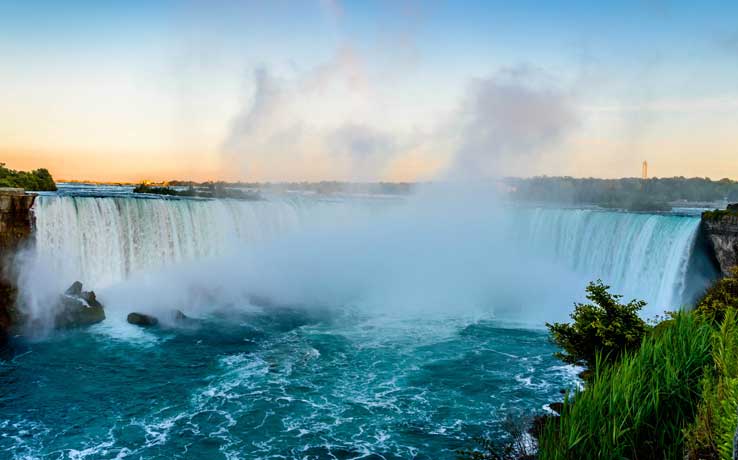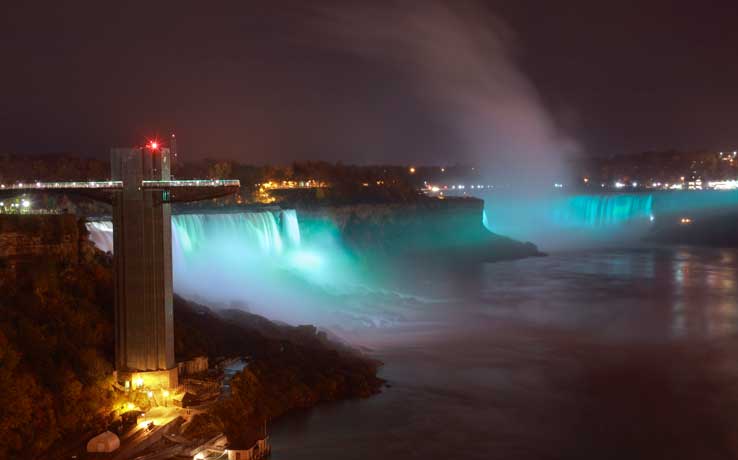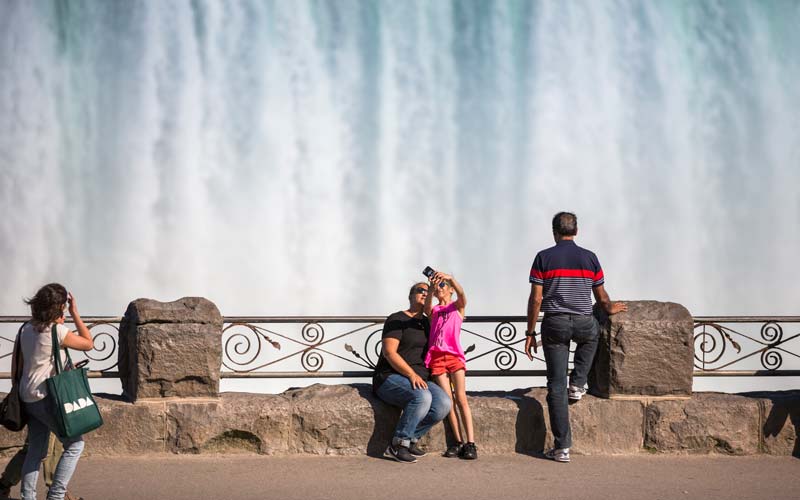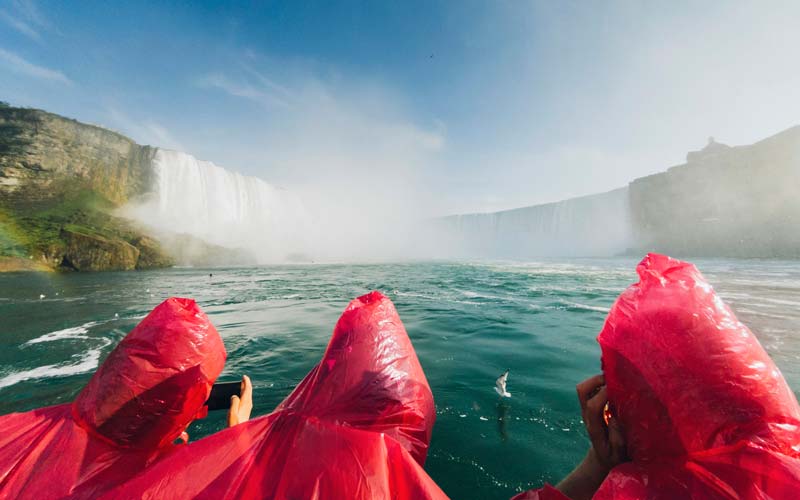Niagara Falls, one of the world’s greatest and most famous natural wonders, hides beneath its mighty and icy waters a series of fascinating curiosities that entertain and educate. Before your next visit to this magical destination, discover 20 fun facts about Niagara Falls that you probably didn’t know yet.
1. Ancient to us, but geologically young!
Niagara Falls began to take shape around 12,000 years ago, at the end of the last Ice Age. As glaciers melted, they formed the Great Lakes, which then flowed into the Niagara River. This mighty river carved its way through the Niagara Escarpment, giving birth to the falls. The transformation isn’t over—erosion is still at work today, slowly shifting the falls upstream as the river shapes the landscape.
2. Niagara Falls Isn’t Just One Waterfall.
By visiting Niagara Falls, you have visited three waterfalls!
90% of the Niagara River’s flow creates the Horseshoe Falls, known as Canadian Falls. This is the largest and most famous of the three falls, shaped like a giant horseshoe. American Falls, entirely situated within the U.S., is renowned for its striking rocky foundation and powerful, roaring waters. The smallest one is Bridal Veil Falls. Luna Island separates the American Falls from Bridal Veil Falls, which, with its gentle flow, appears to create a delicate bridal veil.

3. Niagara Falls: A Natural Powerhouse
More than just a breathtaking natural wonder, Niagara Falls is also a significant source of electricity. Its powerful flow drives massive hydroelectric plants that supply renewable energy to millions of homes in both the United States and Canada, particularly in New York State and Ontario. This energy legacy began in 1896 when electricity was first transmitted from Niagara to Buffalo, New York.
4. Rainbows Are Visible Almost Every Day
If you’re lucky enough to visit Niagara Falls on a sunny day, you’ll almost certainly witness the stunning display of rainbows. The rainbow above the waterfall resembles a royal crown resting on the flowing hair of a fairy. The waterfall, in collaboration with the sun’s rays, creates this magnificent jewel of nature.
5. The Falls Can Be “Turned Off”
In 1969, the U.S. Army Corps of Engineers, aiming to study erosion and assess the stability of the rocks over which the American Falls flowed, managed to “turn off” the waterfall for several months. Building a massive cofferdam on the U.S. side accomplished this extraordinary engineering achievement. After the study was completed, the water flow was returned, restoring the Falls to their natural and awe-inspiring beauty.
6. A rushing waterfall.
Niagara Falls is also famous for the incredible speed at which its water flows. Depending on the season and water levels, the water rushes over the falls at speeds ranging from 35 to 68 miles per hour (56 to 109 kilometres per hour). This powerful current makes Niagara one of the fastest-moving waterfalls on the planet. The sheer force and velocity of the water contribute to the dramatic roar and mist that visitors experience up close, showcasing the immense energy harnessed by this natural wonder.
7. A Nighttime Glow of 16 Million Colours.
While the rainbow gifts its colours to the waterfall during the day, at night, the 16 million colours produced by the LED lighting system make the waterfall both magical and romantic. Since 1925, Niagara Falls has been illuminated every night, offering a show of lights and colours in the darkness. This innovation has turned this natural beauty into a tourist attraction even at night, throughout every season of the year.

8. It Has Its Legend
The “Maid of the Mist” is a well-known Native American legend from the Iroquois (Haudenosaunee) nation near Niagara Falls. It tells the story of a young maiden who sacrifices herself to the powerful spirit of the falls, either as a tribute, to save her people, or to prove her courage. In some versions, she leaps into the misty waters out of Love, refusing to be separated from her beloved. The falls are considered sacred places inhabited by spirits whose breath and voice are the mist and roar of the water. Some stories say the spirit saves the maiden or becomes a guardian of the falls.
9. Niagara: The best place to celebrate Love.
In 1804, Napoleon Bonaparte’s brother chose Niagara for his honeymoon. Thanks to this event, the place gained great fame, and many other couples later chose it as well. For over two centuries, it has proudly held the title of Honeymoon Capital of the World.
This destination meets all the criteria to proudly hold this title, as it blends beauty, magic, and a peaceful atmosphere. It remains a timeless destination for unforgettable romantic getaways.
10. In the rushing waters, there is life.
Would you believe that specific fish species can survive despite the incredible speed and power of the water flowing over the falls? Those that adapted to this extreme habitat managed to endure, while others, unfortunately, could not withstand the overwhelming force of nature.
11. You can go inside the waterfall!
Behind the Canadian Falls, there are artificial tunnels that lead you into the heart of the waterfall. As you walk through these dark passageways, you can feel the force of the crashing water and hear the roar that accompanies this powerful phenomenon. At the end of the tunnels are observation windows that open behind the thundering water curtain at Horseshoe Falls. This is a once-in-a-lifetime opportunity to feel the raw power of nature.
12. Over 25 million tourists visit each year.
Niagara Falls is one of the most popular attractions in the world, and over 25 million tourists visit it every year. Tourists come from every corner of the globe to see this mighty natural wonder. They take boat rides to get close to the heart of the waterfalls and experience them deeply. This has led to the development of a comprehensive infrastructure of hotels and other entertainment activities surrounding the attraction, all of which support tourism.
13. Partially freezes in winter.
Despite the very low winter temperatures, the waterfall does not freeze completely. In 1964, an ice barrier was installed in Lake Erie to prevent the water from freezing during the low winter temperatures. Water continues to flow through large chunks of ice that sparkle under the sunlight. You can never be sure whether the flowing water will melt the giant ice structures or if it will soon turn back into ice itself. Even during the winter season, Niagara Falls knows how to capture attention and remain a popular tourist attraction.
14. Thrill-seekers have attempted to go over the falls in barrels.
For many years, those who are unfamiliar with fear have attempted to go over the falls in barrels. It may seem like a thrilling and extreme experience, but while some have managed to complete it successfully, others have been injured and, unfortunately, even lost their lives. At the age of 63, Annie Edson Taylor, a school teacher, was the first person to go over Niagara Falls in a barrel successfully.
Due to the danger involved, this activity is now considered illegal.
15. Niagara Falls divides and unites two countries.
It is a natural border between Canada and the United States. The Horseshoe Falls, the largest of the three waterfalls, is located on the Canadian side, while the American Falls and Bridal Veil Falls are within the U.S. state. Valued by both countries for their rare natural and cultural beauty, as well as the tourist attractions they offer throughout the year, these two countries cooperate closely to preserve the waterfalls, regulate water flow, and promote tourism.
16. The perfect place for those seeking intense thrills.
Niagara Falls has a zipline for those who want to see the spectacular view of the waterfall from above as it flows. Meanwhile, those looking for the adrenaline of riding its waters and feeling the power of the falls up close can take large boats that bring them right to the base of the roaring water mass.
17. The origin of the name “Niagara”.
The name Niagara truly represents what Niagara is in reality — “thunder of water.” It is believed that the name originates from the Iroquois word “Onguiaahra.” This powerful term was used by the Iroquois people, who lived in the region alongside other Indigenous communities, to describe the extraordinary force and thundering roar of its waters. Later, the name was anglicized, evolving into what we know today as “Niagara.”
18. Rainbow Bridge – connecting two countries.
The Rainbow Bridge crosses the Niagara River and connects Niagara Falls in Ontario with Niagara Falls in New York. Along this bridge, visitors can enjoy breathtaking views of all three waterfalls. Opened in 1941, the bridge serves not only as a piece of infrastructure used daily by pedestrians, cyclists, and vehicles but also as a symbol of connection between the two countries. It gets its name, “Rainbow Bridge,” from the rainbows that frequently appear over the falls.

19. Niagara Falls – a movie set.
Because of its breathtaking beauty and mystery, Niagara Falls has served as a filming location for several movies and television appearances, such as “Superman II” (1980), “Niagara” (1953)—a thriller starring Marilyn Monroe, “Pirates of the Caribbean: At World’s End” (2007), and others.
20. Fossils Discovered in the Area
Traces from the Ordovician period, believed to date back around 400 million years, have been found in the Niagara Gorge. The fossils are primarily the remains of aquatic creatures, providing evidence of the ecosystem and species diversity that once existed in this area during prehistoric times. The layers of rock in which these organisms have been preserved resemble a museum that testifies to history.
Don’t miss visiting Niagara Falls to experience all these fun facts. We invite you to book your Niagara Falls tour with Niagara Falls Tours.













